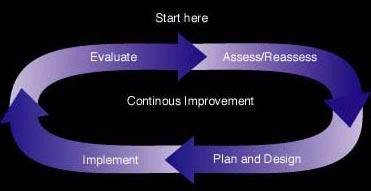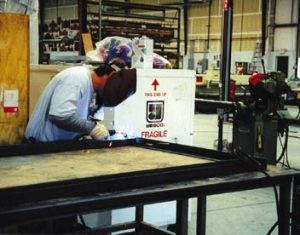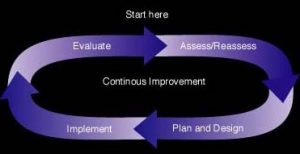Business Management
Transforming Sign Companies
To achieve better results, upgrade your process.
Published
18 years agoon

During the past 25 years, Japanese and Korean automobile manufacturers have claimed a substantial share of the domestic American market. Such brands as Toyota and Honda have established dominant reputations for quality and economy. But many people don’t realize that the "Japanese quality system" was actually created in the United States. W. Edwards Deming, the godfather of modern quality-control systems, was born in Sioux Falls, IA, in 1900. Having earned his Ph.D in mathematical physics at Yale University in 1928, Dr. Deming worked for the National Census Bureau and developed process controls for clerical operations. His work yielded dramatic improvements in government-worker productivity. During World War II, Dr. Deming helped engineers and designers improve processes and reduce waste in factories that produced military equipment and supplies. But when the war ended, and general prosperity arrived, American manufacturers became more concerned with production output than process efficiency. As a result, Deming’s quality-improvement courses received less attention. Managers of leading U.S. manufacturing firms failed to adopt the sweeping organizational changes necessary to establish Deming’s quality system. But in Japan, Deming’s principles helped rebuild a war-ravaged economy. After Deming served as an adviser to the Japanese Census in the immediate post-war period, the Union of Japanese Scientists and Engineers invited him to conduct a series of lectures and seminars in 1950. During these sessions, he taught Japanese industrial managers basic quality-control principles. The Japanese were eager to overcome a widespread perception that they produced inferior products. Much to the chagrin of the American firms that ignored him, Japanese manufacturers rapidly embraced Dr. Deming’s quality system. Thus began the miraculous rise of Japan from the ashes of defeat to her current status as one of the world’s leading industrial powers. Continuous-improvement cycle How does this story pertain to the sign business? Like their auto-industry counterparts, American sign builders have been slow to recognize that organizational changes must precede the effective application of new technologies. Sign professionals have updated their tools and techniques, but many continue to follow the traditional-management model. But, as Deming’s work demonstrates, this model is based on fundamentally flawed assumptions. The centerpiece of Deming’s quality model, the PDSA method, signifies a cyclical repetition of "Plan," "Do," "Study" and "Act" (Fig. 1). Because it demands continual evaluation and adjustment of production processes, PDSA forms the basis of "the learning organization." This model applies to every type of manufacturing operation, regardless of size or resources. The slogan "Plan your work and work your plan" has been popular among American managers for many years. But Deming shows that planning and execution represent only half the process by which organizations learn and improve. Unless a company continuously evaluates the results of new initiatives and, based on these evaluations, institutes concrete process changes, it can’t perform effectively in the modern business arena. This systematic approach to problem solving distinguishes the most successful firms. Because high-volume producers dominate sales in the modern sign industry, a company’s competitive ability increasingly depends on a willingness to adapt the organization. As a result, early adopters of "lean manufacturing" principles have established significant competitive advantages. Focus on quality process Deming says that results can’t improve without improvement of the product-creation process. The Japanese industrial miracle occurred because their companies realized that a series of incremental process improvements often yield far greater benefits than high-profile innovations in technology or equipment. This certainly doesn’t mean that signmakers shouldn’t seek the most modern capital equipment they can afford. But sign-company managers should primarily focus on continuously re-engineering the processes in which these tools are used and their organizational culture. How does this transformation occur? First, each production step must be standardized to enable each employee to follow approved processes. At the same time, however, employees should be encouraged to develop better procedures that allow the existing processes to evolve. Second, the "organizational walls" that divide various departments must be eliminated to allow a free flow of critical information. Employees must understand that their most critical obligations relate to "internal customers," the coworkers who will perform the next production step. Also, employees must realize that "Quality first" is more than an empty slogan. Thus, managers who downplay quality issues, because of excessive concerns about production costs, have placed the cart before the horse. A focus on quality automatically reduces costs and delivery times. Therein lies the genius of the Deming model. But end-of-the-line product inspections represent the wrong approach for a high-quality production system. As large-scale manufacturers are proving every day, high-quality materials and efficient manufacturing processes reduce waste and product defects. Ending the blame game Deming’s model rejects the traditional American practice of management by objectives. This includes using nebulous slogans, exhortations, quotas and other numerical goals based on gross outputs. In Deming’s view, more than 90% of production-efficiency problems are beyond line workers’ control. To solve these problems, therefore, managers must shift their focus from who is wrong to what is wrong. But this can only occur in a non-judgmental company culture that encourages free communication among all departments. Deming says that management must lead this cultural transformation. Management must create and maintain a company-wide commitment to improve products and services, as well as eliminate fear as a motivation, and encourage employee ownership of the evolving processes. To safeguard your company from the overconfidence that opens the door for your competitors, Deming identifies the following "deadly diseases" that continue to afflict many manufacturers: * Lack of a unified purpose in the organization; * An emphasis on short-term goals and profits; * Traditional employee-performance reviews that recognize individual achievements instead of team efforts; * A revolving door of managers, which destroys leadership consistency; and * Managing strictly according to quantitative data while ignoring more subjective and subtle aspects of organizational performance A plan of action Dr. Deming developed the following seven-point plan to transform an organization to meet the challenges of the modern business arena: 1. Management agrees to adopt the Continuous Improvement model and develops plans to implement this model. 2. Each manager takes responsibility in the transformation’s success. 3. Management explains thoroughly to company personnel why this change is necessary and desirable. 4. Each company activity is divided into stages, and the internal customers of personnel operating at each stage are clearly identified. Continuous improvement of methods is prescribed for each stage in the production process; barriers to effective interaction are examined, and plans are developed to eliminate them. 5. Internal mechanisms are quickly instituted to guide continuous quality improvements. 6. Barriers to employee input in process development are removed between different company departments. Any employee is free to contribute to improvements in any sphere of company operations. 7. Quality-assurance systems, such as Total Quality Management and Statistical Process Control are established to verify organization performance and to eliminate production-process variations. The difference it makes Many people still don’t appreciate the ramifications of a sea change that impacted the sign industry during the past 15 years. Because a substantial number of signshops are traditionally managed, the assumption persists that industry-wide practices haven’t changed. But high-volume sign builders, who increasingly dominate sales, recognize that the transformational manager is the quarterback in today’s game of survival. As in other manufacturing industries, formerly prominent sign builders often were tethered to obsolete business models. Conversely, the firms that survive and increase market share typically have integrated key tenets of the Deming model and its Japanese refinement, "Kaizen." Dramatic productivity gains have resulted from following the continuous-improvement model, a blueprint for gaining more from your existing resources by eliminating waste and non-value-adding operations. It improves employee training and makes your company more responsive to customer needs. A customer-driven business organization reads market demands and responds quickly. American sign companies certainly can’t afford to be left behind. For more information, visit the W. Edwards Deming Institute website (www.deming.org) or the Kaizen Institute of America website (www.kaizen-institute.com).

SPONSORED VIDEO
Introducing the Sign Industry Podcast
The Sign Industry Podcast is a platform for every sign person out there — from the old-timers who bent neon and hand-lettered boats to those venturing into new technologies — we want to get their stories out for everyone to hear. Come join us and listen to stories, learn tricks or techniques, and get insights of what’s to come. We are the world’s second oldest profession. The folks who started the world’s oldest profession needed a sign.
You may like

Avery Dennison Adopts Mimaki Printer for Traffic Sign Print System

Fiery Releases SignLab 11

21 Larry Albright Plasma Globes, Crackle Tubes and More
Subscribe

Bulletins
Get the most important news and business ideas from Signs of the Times magazine's news bulletin.
Most Popular
-

 Tip Sheet2 days ago
Tip Sheet2 days agoAlways Brand Yourself and Wear Fewer Hats — Two of April’s Sign Tips
-

 Business Management1 week ago
Business Management1 week agoWhen Should Sign Companies Hire Salespeople or Fire Customers?
-

 Women in Signs2 weeks ago
Women in Signs2 weeks ago2024 Women in Signs Award Winners Excel in Diverse Roles
-

 Real Deal3 days ago
Real Deal3 days agoA Woman Sign Company Owner Confronts a Sexist Wholesaler
-

 Editor's Note1 week ago
Editor's Note1 week agoWhy We Still Need the Women in Signs Award
-

 Maggie Harlow2 weeks ago
Maggie Harlow2 weeks agoThe Surprising Value Complaints Bring to Your Sign Company
-

 Line Time2 weeks ago
Line Time2 weeks agoOne Less Thing to Do for Sign Customers
-

 Product Buying + Technology1 week ago
Product Buying + Technology1 week agoADA Signs and More Uses for Engraving Machines













